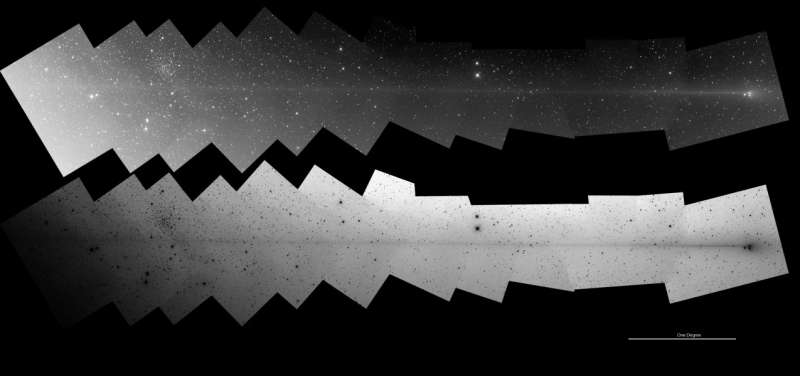Credit & Copyright: Pete Lawrence
(Digital-Astronomy)
Explanation:
Once known as Earth's sunset comet,
PanSTARRS (C/2011 L4) is up all night now, but
only for northern hemisphere skygazers.
Telescopes
are required to track
its progress
as it fades and heads for the outer solar system.
But because planet Earth passed through the comet's orbital
plane in late May, PanSTARRS will also be remembered for its
remarkably long anti-tail.
That edge-on perspective looking along the broad,
fanned-out dust tail
as it trailed behind the comet created the appearance
of an anti-tail pointing in the sunward direction,
back toward the inner solar system.
Recorded on the night of May 27, this 13 pane mosaic
(shown in positive and negative views)
follows PanSTARRS' anti-tail as
it stretches
over 7 degrees from the comet's coma at the far right.
The anti-tail was likely much longer, but gets lost in the evening's
bright moonlight encroaching on the left edge of the scene.
Background star cluster NGC 188 in Cepheus shows up
along the way,
near top left.
1999 2000 2001 2002 2003 2004 2005 2006 2007 2008 2009 2010 2011 2012 2013 2014 2015 2016 2017 2018 2019 2020 2021 2022 2023 2024 2025 |
Yanvar' Fevral' Mart Aprel' Mai Iyun' Iyul' Avgust Sentyabr' Oktyabr' Noyabr' Dekabr' |
NASA Web Site Statements, Warnings, and Disclaimers
NASA Official: Jay Norris. Specific rights apply.
A service of: LHEA at NASA / GSFC
& Michigan Tech. U.
|
Publikacii s klyuchevymi slovami:
comet - komety
Publikacii so slovami: comet - komety | |
Sm. takzhe:
Vse publikacii na tu zhe temu >> | |
